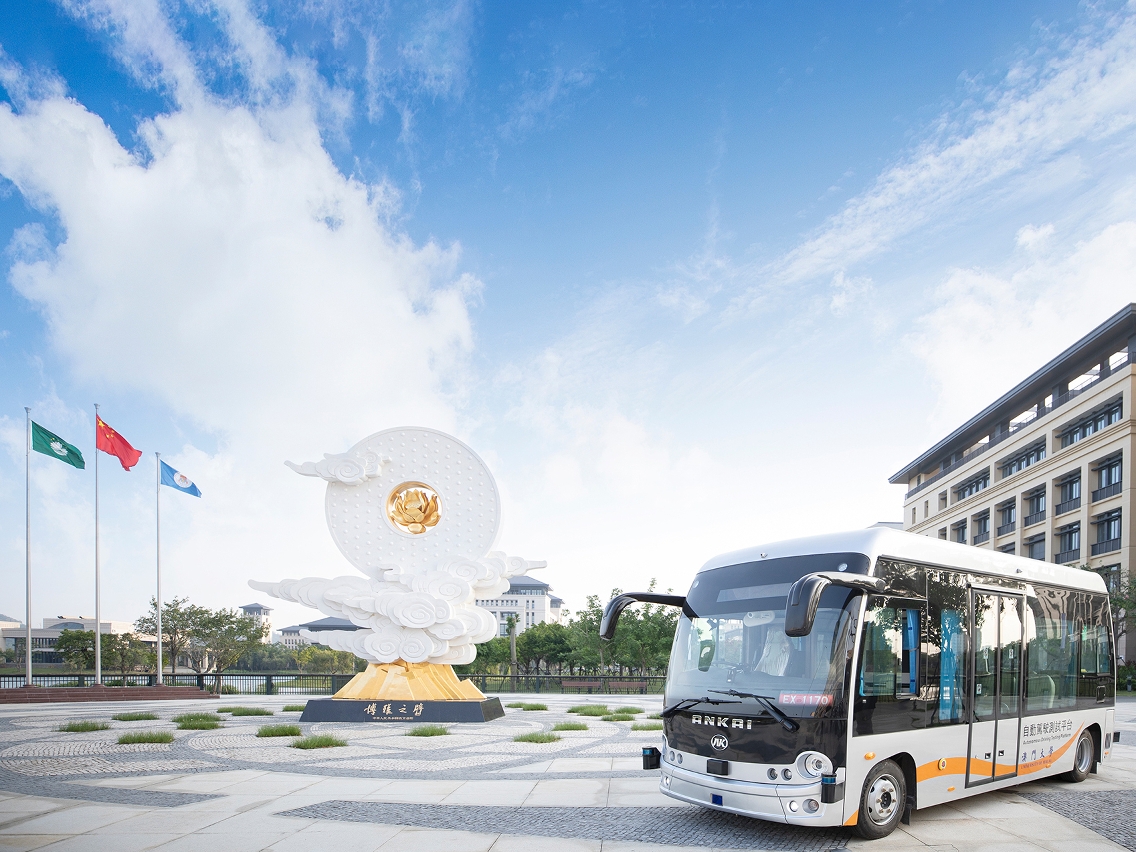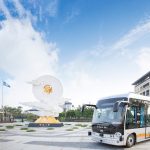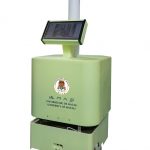 UM tests its new technologies on the self‑driving bus on campus
UM tests its new technologies on the self‑driving bus on campus
The University of Macau (UM) is developing a number of innovative applications based on artificial intelligence technology, including a self-driving bus, unmanned marine vessels, industrial robots, image forgery detection, and software for smart tourism, in order to help develop Macao into a smart city and support the diversification of the local economy with technological innovation.
Among these projects is the self-driving project undertaken by the State Key Laboratory of Internet of Things for Smart City (University of Macau) and its partners from Macao and mainland China. The research team is headed by Prof Xu Chengzhong, dean of UM’s Faculty of Science and Technology. In making self‑driving cars safer, they have launched Macao’s first‑ever self‑driving bus as a testing vehicle at the university. Prof Xu’s team has seen some encouraging results. They have published dozens of papers on related technologies in leading academic journals and presented some other papers at top international conferences. To teach cars to make smart decisions, UM researchers have proposed a new algorithm called Re‑Initialising the Fully‑connected LayEr (RIFLE). Moreover, self‑driving cars must be able to identify everything around them. Convolutional neural networks can usually perform such tasks effectively, but they can be vulnerable when facing cyberattacks or unclear objects. Therefore, Prof Xu’s team has developed the ‘LAFEAT’ algorithm, which can make CNNs more robust to adversarial attacks or noise.
A team led by Carlos Silvestre, a professor in the UM Department of Electrical and Computer Engineering, is developing next‑generation marine vessels that can perform tasks on their own. Team members have also developed algorithms that allow unmanned surface vessels (USVs) to avoid obstacles, return to their start locations when running out of power, and cope with unexpected situations. Since winning a first prize at an international intelligent vessel competition in 2020, the team has been designing underwater robots with sonar sensors that can produce high‑resolution underwater images even in low‑visibility conditions. After typhoons or other natural disasters, it will be possible to use the vessel to check whether underwater facilities are damaged in the waters of Macao where visibility is low.
Xu Qingsong, a professor in the Department of Electromechanical Engineering, is leading a team to build innovative intelligent robots. Prof Xu has already developed a second-generation disinfection robot called ‘Smart Cleaner’. According to Prof Xu, UM has filed a patent application for the robot technology. The university is also talking with companies for patent transfer, in order to bring the robots on the market. His team is also developing a next‑generation industrial robot with three‑dimensional visual perception and compliant force control. His team plans to use the new robot to assemble parts of devices, polish cars, and maintain aircraft. Prof Xu’s team has also developed an intelligent micromanipulation robot system that can automatically control microinjectors and microgrippers at the micro- to nano- scale for cell operations such as gene editing. They are also supported by the Zhuhai UM Science & Technology Research Institute to transform their research results into marketable products.
Associate Professor Zhou Jiantao in the Department of Computer and Information Science, who is also the interim head of UM’s Centre for Artificial Intelligence and Robotics, has developed a cutting‑edge algorithm to detect image forgery, with the support of the Super Intelligent Computing Centre at UM. After defeating over 1,500 rivals at an international competition, they have continued to improve the algorithm under a one‑year project with the e‑commerce giant Alibaba. The tech company is sponsoring Prof Zhou’s team to develop an algorithm that can accurately detect forged parts of images even if they have been compressed by different media, resized, filtered, or contain added noise.
Prof Gong Zhiguo, head of UM’s Department of Computer and Information Science, and his postgraduate students have designed new algorithms that use social media data to evaluate the tourists’ sentiments to identify their favourite places and activities in Macao, as well as to detect and predict emergent events. Furthermore, the researchers have used social media data to calculate the density of tourists in different areas over the course of the day. Prof Gong says such statistics can inform government planning for tourist facilities and the transport system. To help residents and tourists get around the city while avoiding traffic jams, Prof Gong’s research team plans to launch another mobile application that can show real‑time congestion levels on a map and make predictions accordingly, aiming to offer better and smarter travel experiences to tourists in Macao.



